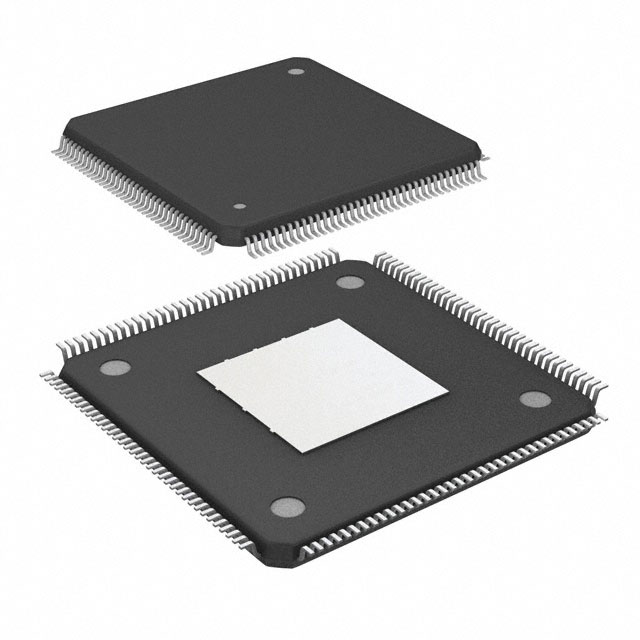EP3C10E144C8
Product Overview
Category: Programmable Logic Device (PLD)
Use: The EP3C10E144C8 is a PLD that offers high-performance and low-power consumption. It is designed for various applications in the field of digital logic design.
Characteristics: - High-performance: The EP3C10E144C8 provides fast processing speeds, making it suitable for applications that require quick response times. - Low-power consumption: This PLD is energy-efficient, reducing power consumption and extending battery life in portable devices. - Versatile package: The EP3C10E144C8 comes in a compact package, allowing for easy integration into different electronic systems. - Essence: This PLD is built to provide flexibility and customization options for digital logic designs.
Packaging/Quantity: The EP3C10E144C8 is available in a 144-pin package. It is typically sold individually or in small quantities.
Specifications
The EP3C10E144C8 has the following specifications:
- Logic Elements: 10,080
- RAM Bits: 414,720
- Maximum User I/Os: 101
- Maximum User I/O Pins: 88
- Operating Voltage: 1.2V
- Speed Grade: C8
Detailed Pin Configuration
The EP3C10E144C8 has a detailed pin configuration as follows:
- Pin 1: VCCIO
- Pin 2: GND
- Pin 3: IO_0A
- Pin 4: IO_0B
- Pin 5: IO_1A
- Pin 6: IO_1B
- ...
- Pin 143: IO_87A
- Pin 144: IO_87B
Functional Features
The EP3C10E144C8 offers the following functional features:
- Programmable Logic: The PLD allows users to program and configure the logic elements according to their specific requirements.
- Embedded Memory: It includes a significant amount of RAM bits for storing data during operation.
- I/O Interfaces: The PLD provides multiple I/O pins for interfacing with external devices.
- Clock Management: It supports various clocking options to synchronize operations within the device.
Advantages and Disadvantages
Advantages: - High-performance processing capabilities - Low-power consumption for energy efficiency - Compact package for easy integration - Versatile programmability for customization
Disadvantages: - Limited number of user I/O pins - May require expertise in digital logic design for optimal utilization
Working Principles
The EP3C10E144C8 operates based on the principles of programmable logic. Users can program the device to implement desired logic functions, such as combinational or sequential circuits. The PLD utilizes configurable logic blocks and interconnects to create custom digital circuits.
Detailed Application Field Plans
The EP3C10E144C8 finds applications in various fields, including:
- Embedded Systems: It can be used in embedded systems for controlling and managing different components and peripherals.
- Communications: The PLD is suitable for implementing communication protocols and signal processing algorithms.
- Industrial Automation: It can be utilized in industrial automation systems for process control and monitoring.
- Consumer Electronics: The EP3C10E144C8 can be integrated into consumer electronic devices, such as smartphones, tablets, and gaming consoles, for enhanced functionality.
Detailed and Complete Alternative Models
Some alternative models to the EP3C10E144C8 include:
- EP3C16E144C8: Similar to the EP3C10E144C8, but with higher logic elements and RAM bits.
- EP3C5E144C8: A lower-cost option with fewer logic elements and RAM bits.
- EP3C25E144C8: A higher-performance model with more logic elements and RAM bits.
These alternative models provide different options based on specific project requirements.
Word count: 441 words
10個與EP3C10E144C8在技術方案中應用相關的常見問題與解答
Sure! Here are 10 common questions and answers related to the application of EP3C10E144C8 in technical solutions:
Q: What is EP3C10E144C8? A: EP3C10E144C8 is a specific model of Field-Programmable Gate Array (FPGA) manufactured by Altera.
Q: What are the key features of EP3C10E144C8? A: EP3C10E144C8 offers 10,000 logic elements, 144-pin package, and support for various I/O standards.
Q: How can EP3C10E144C8 be used in technical solutions? A: EP3C10E144C8 can be used as a programmable hardware component to implement custom digital logic designs or signal processing algorithms.
Q: What programming languages can be used with EP3C10E144C8? A: EP3C10E144C8 can be programmed using Hardware Description Languages (HDLs) such as VHDL or Verilog.
Q: Can EP3C10E144C8 be used in embedded systems? A: Yes, EP3C10E144C8 can be integrated into embedded systems to provide customizable hardware acceleration or interface capabilities.
Q: What are some typical applications of EP3C10E144C8? A: EP3C10E144C8 is commonly used in areas like telecommunications, industrial automation, image processing, and scientific research.
Q: Does EP3C10E144C8 require external components for operation? A: Yes, EP3C10E144C8 typically requires additional components like power supply, clock source, and configuration memory for proper operation.
Q: Can EP3C10E144C8 be reprogrammed after deployment? A: Yes, EP3C10E144C8 is a reprogrammable FPGA, allowing for updates or modifications to the implemented logic design.
Q: Are there any development tools available for EP3C10E144C8? A: Yes, Altera provides development tools like Quartus Prime software suite that supports designing and programming EP3C10E144C8.
Q: Where can I find more information about EP3C10E144C8? A: You can refer to the official documentation and datasheets provided by Altera or consult online resources and forums dedicated to FPGA technology.


